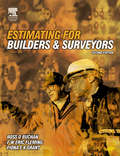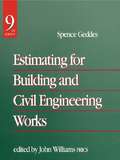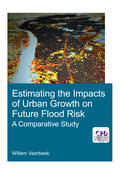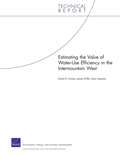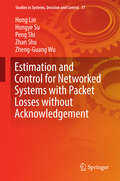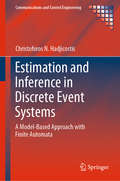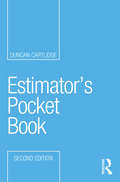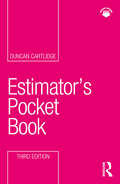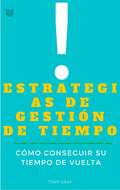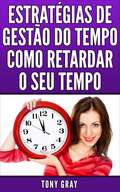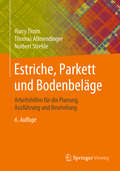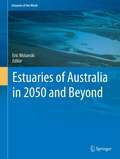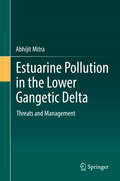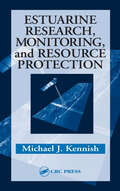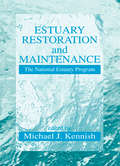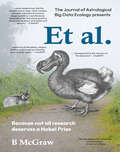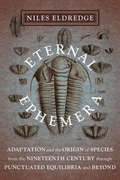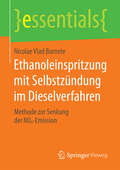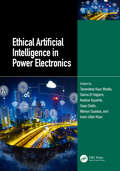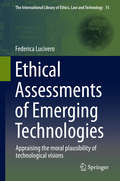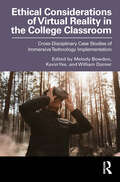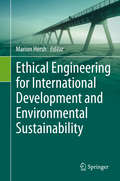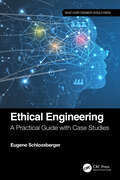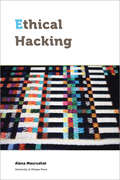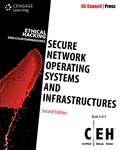- Table View
- List View
Estimating for Builders and Surveyors
by Fiona Grant Eric Fleming R D BuchanWritten for students taking courses in building and surveying, 'Estimating for Builders and Surveyors' describes and explains the method used by the estimator to build up prices or rates for items described in the SMM7 format. Each chapter is a self-contained unit related to a particular element in the building. Worked examples throughout reflect both traditional and up-to-date technology. Written by an author team of academics and professional surveyors, this book continues to be an invaluable introduction to the subject of estimating.
Estimating for Building & Civil Engineering Work
by John Williams Spence gedesIt deals in a practical and reasonable way with many of the estimating problems which can arise where building and civil engineering works are carried out and to include comprehensive estimating data within the guidelines of good practice. The early part of the book has been completely rewritten to contain chapters useful to students and practitioners alike for the development of the estimating process resulting in the presentation of a tender for construction works. The second and major part of the book contains estimating data fully updated for the major elements in building and civil engineering work, including a new chapter on piling, and a wealth of constants for practical use in estimating. The estimating examples are based on the current edition of the Standard Method of Measurement for Building Works (SMM7). The comprehensive information on basic principles of estimating found in 'Spence Geddes' are still as valid today as the first edition. In this edition the prevailing rates of labour and costs of materials are taken whenever possible as a round figure. Readers will appreciate in the construction industry that prices are continually changing, rise and fall, and that worked examples should therefore be used as a guide to method of calculation substituting in any specific case the current rates applicable to it. In the case of plant output dramatic increases have been experienced in productivity over recent years and again estimators with their own records should substitute values appropriate to their work.
Estimating the Impacts of Urban Growth on Future Flood Risk: A Comparative Study (IHE Delft PhD Thesis Series)
by Willem VeerbeekThe unprecedented growth of cities has a significant impact on future flood risk that might exceed the impacts of climate change in many metropolitan areas across the world. Although the effects of urbanisation on flood risk are well understood, assessments that include spatially explicit future growth projections are limited. This comparative study provides insight in the long term development of future riverine and pluvial flood risk for 18 fast growing megacities. The outcomes provide not only a baseline absent in current practise, but also a strategic outlook that might better establish the role of urban planning in limiting future flood risk.
Estimating the Value of Water-Use Efficiency in the Intermountain West
by James Griffin Sara Hajiamiri David G. GrovesThis report presents an economic framework for estimating a water agency's avoided costs and environmental benefits of increasing water-use efficiency. The report demonstrates this framework by evaluating the benefits of Denver Water's efficiency programs and utilizes an exploratory modeling approach to accommodate significant uncertainty. The analysis highlights the importance of considering both long- and short-run costs and benefits.
Estimation and Control for Networked Systems with Packet Losses without Acknowledgement
by Peng Shi Hong Lin Hongye Su Zhan Shu Zheng-Guang WuThis book discusses recent advances in the estimation and control of networked systems with unacknowledged packet losses: systems usually known as user-datagram-protocol-like. It presents both the optimal and sub-optimal solutions in the form of algorithms, which are designed to be implemented easily by computer routines. It also provides MATLAB(r) routines for the key algorithms. It shows how these methods and algorithms can solve estimation and control problems effectively, and identifies potential research directions and ideas to help readers grasp the field more easily. The novel auxiliary estimator method, which is able to deal with estimators that consist of exponentially increasing terms, is developed to analyze the stability and convergence of the optimal estimator. The book also explores the structure and solvability of the optimal control, i. e. linear quadratic Gaussian control. It develops various sub-optimal but efficient solutions for estimation and control for industrial and practical applications, and analyzes their stability and performance. This is a valuable resource for researchers studying networked control systems, especially those related to non-TCP-like networks. The practicality of the ideas included makes it useful for engineers working with networked control.
Estimation and Inference in Discrete Event Systems: A Model-Based Approach with Finite Automata (Communications and Control Engineering)
by Christoforos N. HadjicostisEstimation and Inference in Discrete Event Systems chooses a popular model for emerging automation systems—finite automata under partial observation—and focuses on a comprehensive study of the key problems of state estimation and event inference. The text includes treatment of current, delayed, and initial state estimation. Related applications for assessing and enforcing resiliency—fault detection and diagnosis—and security—privacy and opacity—properties are discussed, enabling the reader to apply these techniques in a variety of emerging applications, among them automated manufacturing processes, intelligent vehicle/highway systems, and autonomous vehicles. The book provides a systematic development of recursive algorithms for state estimation and event inference. The author also deals with the verification of pertinent properties such as:the ability to determine the exact state of a system, “detectability”;the ability to ensure that certain classes of faults can be detected/identified, “diagnosability”; andthe ability to ensure that certain internal state variables of the system remain “hidden” from the outside world regardless of the type of activity that is taking place, “opacity”. This book allows students, researchers and practicing engineers alike to grasp basic aspects of state estimation in discrete event systems, aspects like distributivity and probabilistic inference, quickly and without having to master the entire breadth of models that are available in the literature.
Estimator's Pocket Book 2e (Routledge Pocket Books)
by Duncan CartlidgeThe Estimator’s Pocket Book, Second Edition is a concise and practical reference covering the main pricing approaches, as well as useful information such as how to process sub-contractor quotations, tender settlement and adjudication. It is fully up to date with NRM2 throughout, features a look ahead to NRM3 and describes the implications of BIM for estimators. It includes instructions on how to handle: the NRM order of cost estimate; unit-rate pricing for different trades; pro-rata pricing and dayworks; builders’ quantities; approximate quantities. Worked examples show how each of these techniques should be carried out in clear, easy-to-follow steps. This is the indispensable estimating reference for all quantity surveyors, cost managers, project managers and anybody else with estimating responsibilities. Particular attention is given to NRM2, but the overall focus is on the core estimating skills needed in practice. Updates to this edition include a greater reference to BIM, an update on the current state of the construction industry as well as up-to-date wage rates, legislative changes and guidance notes.
Estimator’s Pocket Book (Routledge Pocket Books)
by Duncan CartlidgeThe Estimator’s Pocket Book, Third Edition is a concise and practical reference covering the main approaches to pricing, as well as useful information such as how to process sub-contractor quotations, tender settlement and adjudication. It is fully up to date with the New Rules of Measurement (NRM2) (2nd Edition) throughout and based on up-to-date wage rates, legislative changes and guidance notes.The book includes instructions on how to carry out:· an NRM order of cost estimate,· unit-rate pricing for a range different trades,· pro rata pricing for variations, and· the preparation and pricing of builders’ quantities and approximate quantities.This book is an essential source of reference for quantity surveyors, cost managers, project managers and anybody else with estimating responsibilities.
Estrategias de Gestión de Tiempo. Cómo conseguir su tiempo de Vuelta
by Gabriela R. Morales Castro Tony GrayLa Gestión del tiempo es clave para el éxito en la vida personal y profesional. Este libro es un atajo al punto de leer para aquellos que se encuentran haciendo cosas que no deberían estar haciendo, por lo tanto, utilizando el tiempo precioso durante el día. Este libro tiene referencias a gran cantidad de estudios específicos y sus conclusiones sobre la gestión del tiempo y formas en que las personas pierden el tiempo. Estoy seguro de se que dará cuenta de que de que lo que dicen es correcto y siempre caemos en algunas de estas trampas. Imagine lo que podría lograr con su vida si usted abordara la disciplina de la gestión del tiempo. Aprenda a gestionar eficazmente su tiempo y energía a través de su lista de cosas por hacer en un tiempo récord. Esta guía completa le ayudará a dominarlo rápidamente, en lugar de permitir que su tiempo lo domine a usted. En el interior encontrará ... • Cómo dar prioridad a su lista de tareas pendientes? • Cómo usar la regla 80/20 para trabajar en su vida? Cómo evitar los ahogos de tiempo • Por qué el multitasking le hará perder tiempo? • Cómo establecer expectativas realistas • Y mas! Estrategias de gestión del tiempo para los estudiantes, estrategias de gestión del tiempo para docentes y estrategias de gestión del tiempo para enfermeras y más ...
Estratégias de Gestão do Tempo Como Retardar o Seu Tempo
by Fabiana Rodrigues Castelo Branco Tony GrayEste livro é a solução para aqueles que se encontram fazendo coisas que não deviam estar fazendo, portanto esgotando o tempo precioso durante o dia. Ele contem referências a muitos estudos específicos e suas conclusões sobre a gestão do tempo e as maneiras que as pessoas perdem tempo. Estou certo de que você encontrará o que eles dizem é correto e que sempre caímos em algumas destas armadilhas. Imagine o que você poderia realizar em sua vida se lidasse com a disciplina de gestão de tempo. Aprenda como efetivamente gerenciar o seu tempo e energia através de sua lista de tarefas em tempo recorde. Este manual abrangente lhe ajudará a rapidamente se aprimorar em relação ao se tempo, ao invés de permitir que o seu tempo o faça em relação a você. Você encontrará... * Como priorizar a sua lista de tarefas * Como fazer com que a regra 80/20 funcione em sua vida. Como desligar os sugadores de tempo * Por que as tarefas simultâneas tornarão você vagaroso * Como definir expectativas realistas * E mais! Estratégias de Gestão do Tempo para estudantes, Estratégias de Gestão do Tempo para aprofessores e estratégias de gestão do tempo para enfermeiras e outros...
Estriche, Parkett und Bodenbeläge: Arbeitshilfen für die Planung, Ausführung und Beurteilung
by Harry Timm Thomas Allmendinger Norbert StrehleDieses Fachbuch bietet einen guten Überblick technischer Grundlagen der Estrichplanung wie zum Beispiel Verlegearten, Festigkeit, Abdichtungen, Schall- und Wärmeschutz. Weitere Inhalte sind Leistungsbeschreibungen und Details spezieller Einsatzbereiche unter Berücksichtigung von Standardkonstruktionen nach Norm als auch Sonderausführungen. Dabei legt der Autor besonderen Fokus auf den Aspekt der Qualitätssicherung wie Bauüberwachung und Prüfung. Sind Schwachstellen und Nachteile bestimmter Konstruktionsarten oder Baumaterialien erkannt, kann späteren Estrichschäden vorgebeugt werden. Zahlreiche Zeichnungen und Tabellen geben Darstellungen zu Beispielkonstruktionen und technischen Werten. Hinweise für Vor- und Nachgewerke tragen dazu bei, eine reibungslose Integration des Estrichs in die Gesamtbauleistung sicherzustellen.
Estuaries of Australia in 2050 and beyond
by Eric WolanskiThe book addresses the questions: Is Australia's rapidly growing human population and economy environmentally sustainable for its estuaries and coasts? What is needed to enable sustainable development? To answer these questions, this book reports detailed studies of 20 iconic Australian estuaries and bays by leading Australian estuarine scientists. That knowledge is synthesised in time and space across Australia to suggest what Australian estuaries will look like in 2050 and beyond based on socio-economic decisions that are made now, and changes that are needed to ensure sustainability. The book also has a Prologue by Mr Malcolm Fraser, former Prime Minister of Australia, which bridges environmental science, population policy and sustainability.
Estuarine Pollution in the Lower Gangetic Delta: Threats and Management
by Abhijit MitraThis book critically analyzes the water quality in the lower Gangetic delta, and examines the environmental conditions and physical processes operating in this rich ecosystem. Readers with an interest in environmental science, geography, oceanography, marine biology, environmental biology, aquatic pollution and ecology will find the research presented here most appealing. Readers will discover critical aspects of the chemistry of the estuarine water (particularly that of Hooghly and Matla estuaries) in the lower stretch of the delta region along with the causes and effects of pollution in and around this region. Particular attention is given to the bioaccumulation of conservative pollutants in edible fishes and floral communities thriving in this region. Several case studies are also incorporated to highlight the vulnerability of pollution in this region. Chapters also address the impacts of climate change (specifically acidification) on the concentration and behavior of conservative pollutants. Finally, the book highlights some mitigation measures at the technology and policy level to minimize the negative impacts posed by different groups of pollutants on the estuarine biodiversity.
Estuarine Research, Monitoring, and Resource Protection (CRC Marine Science)
by Michael J. KennishThe ongoing growth of human populations within US coastal regions continues to increase habitat loss, eutrophication, organic loading, overfishing, and other anthropogenic stressors in estuarine waters. The National Estuarine Research Reserve System (NERRS) is a federally funded initiative that addresses these critical estuarine problems an
Estuary Restoration and Maintenance: The National Estuary Program
by Michael J. KennishThis timely volume examines the work of the National Estuary Program, the prominent federally-funded initiative dealing with pollution and other anthropogenic impacts on estuarine ecosystems and the management plans necessary to ensure that these invaluable natural treasures remain healthy and productive for future generations.Estuary Resto
Et al: Because not all research deserves a Nobel Prize
by B McGrawEt al. is a satirical academic journal that uses machine learning and scientific principles on absurd studies, from the cat Lord Whiskers' role in the extinction of the dodo bird to the quantum mysteries of untidy toddler rooms.Key FeaturesConducts satirical research on topics ranging from quantum computing to clingy robot dog algorithmsAnswers questions like “Can a computer understand a Scotsman?” and “Is Sarah Palin real?”Secures the power grid and your home from the prying eyes of government drones a.k.a. birdsExpands science by studying cow-based atmospheres, and the flavortown center of the brainSolves climate change and saves the world by proposing a banana-based fission reactorNullifies the possibility of getting lost at the fair with a mirror-house escape algorithmBook DescriptionTired of the same old math, science, statistics, and programming memes people post online and want something a little more elaborate? This is the book for you. Tremble as we make up all our own facts and data, hand-draw diagrams in MS Paint, and quote from fictional studies and journals. Cower as authors write in the first person because their study is just a little too personal for them. Recoil from the sheer mass of oversimplified methodology, distilling someone's entire thesis into a paragraph of jokes crude enough to make it into a Mike Myers movie. Over the last few years, we have taken arguments that you would normally have after four Jack and cokes at game night and turned them into properly formatted research papers with a writing tone serious enough to confuse the uninitiated. These papers are high-effort jokes by researchers and scientists for researchers and scientists. They cover a range of topics such as the consequences of re-releasing tourists back into Yellowstone National Park after COVID-19, how to play StarCraft competitively online on a quantum computer, and most importantly, how trees around the globe are becoming increasingly radicalized.What you will learnHow to draw a graph using MS Paint, maybeWhether Sarah Palin is a figment of your imaginationHow one pirate cat brought about the extinction of the beloved dodoWhy rabbits used to be jerks back in the dayIf you actually learn anything from these articles, get your memory erased immediatelyWho this book is forThis book is for researchers and those who love science mingled with humor. It's for those who are a little too tired of the talking heads and futurists of the science world and would like something more entertaining in the form of absurd speculative studies by researchers as unbelievable as their work. Anyone who has experienced academic writing, or the tribulations of any research institution will enjoy the wide range of bizarre, yet real-world topics compiled in this book. Even if you don't know much about the subject, we usually have a background section.
Eternal Ephemera: Adaptation and the Origin of Species from the Nineteenth Century through Punctuated Equilibria and Beyond
by Niles EldredgeFrom one of evolutionary biology's major contributors, a compelling work that unravels science's great "Mystery of Mysteries": how new species arise.
Ethanoleinspritzung mit Selbstzündung im Dieselverfahren: Methode zur Senkung der NOx-Emission (essentials)
by Nicolae Vlad BurneteNicolae Vlad Burnete beschreibt ein neues Verbrennungsverfahren im Dieselmotor, wobei eine Diesel-Voreinspritzung zu den erforderlichen Selbstzündungsbedingungen einer Ethanol-Haupteinspritzung führt. Seine Ergebnisse zeigen, dass die Schadstoffemissionen aufgrund einer geringeren Maximaltemperatur erheblich verringert werden können, während der Motorwirkungsgrad aufgrund einer erhöhten Effizienz der Verbrennung gleichzeitig erhöht wird. Dieses essential ist ein geeigneter Beitrag für eine grundsätzliche Umstrukturierung der Fahrzeugantriebe, weil nicht hauptsächlich die katalytische Nachbehandlung, sondern grundsätzlich die Prozesse im Brennraum das höchste Potenzial dafür bieten.
Ethical Artificial Intelligence in Power Electronics
by Keshav Kaushik Mariya Ouaissa Inam Ullah Khan Salma El Hajjami Tarandeep Kaur Bhatia Gayo DialloThis book focuses on the techniques of artificial intelligence that are mainly used in the power electronics field for the optimization of lost vehicle power. With the intention of optimizing the powerful energy of the vehicles and producing reliable energy, the most efficient methods, algorithms, and strategies of ethical artificial intelligence (AI) are being applied. By employing machine learning methods, the optimization of power energy in vehicles can be quickly recovered and managed efficiently. In today’s bustling world, power energy is indispensable for progress, yet in congested Vehicular Ad-hoc Networks (VANETs), vehicles often face power depletion and decreased efficiency. This book explores these challenges, encompassing not only power but also other critical power electronics within vehicles. We aim to introduce innovative approaches, leveraging ethical AI methods, to optimize energy performance in the face of these difficulties. Through this exploration, we seek to provide practical insights into navigating congested VANET environments while upholding ethical principles in technological advancements. Our book will discuss the current power energy concerns faced by vehicles and also contribute a novel strategy to overcome those concerns. The employment of ethical AI in vehicular power energy will undoubtedly improve the effectiveness and production of vehicles.
Ethical Assessments of Emerging Technologies
by Federica LuciveroThis book systematically addresses the issue of assessing the normative nature of visions of emerging technologies in an epistemologically robust way. In the context of democratic governance of emerging technologies, not only it is important to reflect on technologies' moral significance, but also to address their emerging and future oriented character. The book proposes an original approach to deal with the issue of "plausible" ethical evaluation of new technologies. Taking its start from current debates about Technology Assessment, the proposed solution emerges as a combination of theoretical and methodological insights from the fields of Philosophy of Technology, Science and Technology Studies and a normative justification based on pragmatist ethics. The book's main contribution is to engage a diverse and interdisciplinary audience (ethicists, philosophers, social scientists, technology assessment researchers and practitioners) in a reflection concerning the epistemological challenges that are associated to the endeavour of appraising the moral significance of emerging technologies in the attempt of democratically governing them. It brings together concepts and methodologies from different disciplines and shows their synergy in applying them to two specific case studies of emerging biomedical technologies.
Ethical Considerations of Virtual Reality in the College Classroom: Cross-Disciplinary Case Studies of Immersive Technology Implementation
by Melody Bowdon Kevin Yee William DornerEthical Considerations of Virtual Reality in the College Classroom collects case studies that address both pedagogical and ethical foundations of extended reality tools in postsecondary learning environments across disciplines. With today’s institutional programs and faculty leveraging cutting-edge virtual, augmented, and mixed reality opportunities to teach and promote achievement goals, it is imperative that new research into these technologies speaks directly to their challenges and affordances within broad academic settings. This book showcases real-world examples of faculty members who chronicle and develop their use of VR tools across learning contexts and student populations by creating their own digital experiences, adapting open-source tools, integrating commercial products, amplifying crucial course content, analyzing outcomes data, and more. Nontechnical readers will come away with a new understanding of key terms and concepts associated with virtual reality and essential heuristics for evaluating the ethical implications of immersive approaches.
Ethical Engineering for International Development and Environmental Sustainability
by Marion HershEnsuring that their work has a positive influence on society is a responsibility and a privilege for engineers, but also a considerable challenge. This book addresses the ways in which engineers meet this challenge, working from the assumption that for a project to be truly ethical both the undertaking itself and its implementation must be ethically sound. The contributors discuss varied topics from an international and interdisciplinary perspective, including l robot ethics; l outer space; l international development; l internet privacy and security; l green branding; l arms conversion; l green employment; and l deliberate misinformation about climate change Important questions are answered, such as l what is meant by engineering ethics and its practical implications; l how decisions made by engineers in their working lives make an impact at the global as well as the local level; and l what ethics-related questions should be asked before making such decisions. Ethical Engineering for International Development and Environmental Sustainability will be a valuable resource for practising and student engineers as well as all who are interested in professional ethics, especially as it relates to engineering. Researchers and policy makers concerned with the effects of engineering decisions on environmental sustainability and international stability will find this book to be of special interest.
Ethical Engineering: A Practical Guide with Case Studies (What Every Engineer Should Know)
by Eugene SchlossbergerEthical Engineering: A Practical Guide with Case Studies provides detailed and practical guidance in making decisions about the many ethical issues practicing engineers may face in their professional lives. It outlines a decision-making procedure and helps engineers construct an ethics toolkit consisting of professional models, a comprehensive set of ethical considerations and factors that help in weighing those considerations, and analyses of particular issues, such as reverse engineering a patented process. Illustrating case studies, both brief and detailed, are provided. Features: • Introduces the nature of ethical decision-making as applied to engineering values and issues. • Helps readers develop a detailed ethics toolkit that identifies options and solutions and allows them to monitor and adjust as necessary. • Features topics such as safety, sustainability, bioethics, diversity and equality, information technology and AI, as well as critical areas often overlooked in engineering texts, such as mentoring, advertising (for consulting firms), engineering sales, and much more. • Includes 85 case studies to illustrate a variety of scenarios. • Offers an international perspective with codes of ethics from around the world, including Saudi Arabia, India, New Zealand, Chile, and Japan. Emphasizing the importance of the moral life and of engineering as an occupation with high ideals, this book helps readers navigate a variety of real-world ethical issues they are likely to face in this increasingly interdisciplinary, global, and diverse profession.
Ethical Hacking (Law, Technology and Media)
by Alana MaurushatHow will governments and courts protect civil liberties in this new era of hacktivism? Ethical Hacking discusses the attendant moral and legal issues. The first part of the 21st century will likely go down in history as the era when ethical hackers opened governments and the line of transparency moved by force. One need only read the motto “we open governments” on the Twitter page for Wikileaks to gain a sense of the sea change that has occurred. Ethical hacking is the non-violent use of a technology in pursuit of a cause—political or otherwise—which is often legally and morally ambiguous. Hacktivists believe in two general but spirited principles: respect for human rights and fundamental freedoms, including freedom of expression and personal privacy; and the responsibility of government to be open, transparent and fully accountable to the public. How courts and governments will deal with hacking attempts which operate in a grey zone of the law and where different ethical views collide remains to be seen. What is undisputed is that Ethical Hacking presents a fundamental discussion of key societal questions. A fundamental discussion of key societal questions. This book is published in English. - La première moitié du XXIe siècle sera sans doute reconnue comme l’époque où le piratage éthique a ouvert de force les gouvernements, déplaçant les limites de la transparence. La page twitter de Wikileaks enchâsse cet ethos à même sa devise, « we open governments », et sa volonté d’être omniprésent. En parallèle, les grandes sociétés de technologie comme Apple se font compétition pour produire des produits de plus en plus sécuritaires et à protéger les données de leurs clients, alors même que les gouvernements tentent de limiter et de décrypter ces nouvelles technologies d’encryption. Entre-temps, le marché des vulnérabilités en matière de sécurité augmente à mesure que les experts en sécurité informatique vendent des vulnérabilités de logiciels des grandes technologies, dont Apple et Google, contre des sommes allant de 10 000 à 1,5 million de dollars. L’activisme en sécurité est à la hausse. Le piratage éthique est l’utilisation non-violence d’une technologie quelconque en soutien d’une cause politique ou autre qui est souvent ambigue d’un point de vue juridique et moral. Le hacking éthique peut désigner les actes de vérification de pénétration professionnelle ou d’experts en sécurité informatique, de même que d’autres formes d’actions émergentes, comme l’hacktivisme et la désobéissance civile en ligne. L’hacktivisme est une forme de piratage éthique, mais également une forme de militantisme des droits civils à l’ère numérique. En principe, les adeptes du hacktivisme croient en deux grands principes : le respect des droits de la personne et les libertés fondamentales, y compris la liberté d’expression et à la vie privée, et la responsabilité des gouvernements d’être ouverts, transparents et pleinement redevables au public. En pratique, toutefois, les antécédents comme les agendas des hacktivistes sont fort diversifiés. Il n’est pas clair de quelle façon les tribunaux et les gouvernements traiteront des tentatives de piratage eu égard aux zones grises juridiques, aux approches éthiques conflictuelles, et compte tenu du fait qu’il n’existe actuellement, dans le monde, presque aucune exception aux provisions, en matière de cybercrime et de crime informatique, liées à la recherche sur la sécurité ou l’intérêt public. Il sera également difficile de déterminer le lien entre hacktivisme et droits civils. Ce livre est publié en anglais.
Ethical Hacking And Countermeasures: Secure Network Operating Systems and Infrastructures (Second Edition)
by EC-CouncilThe EC-Council|Press Ethical Hacking and Countermeasures series is comprised of four books covering a broad base of topics in offensive network security, ethical hacking, and network defense and countermeasures. The content of this series is designed to immerse the reader into an interactive environment where they will be shown how to scan, test, hack, and secure information systems. A wide variety of tools, viruses, and malware is presented in these books, providing a complete understanding of the tactics and tools used by hackers. The full series of books helps prepare readers to take and succeed on the C|EH certification exam from EC-Council.
